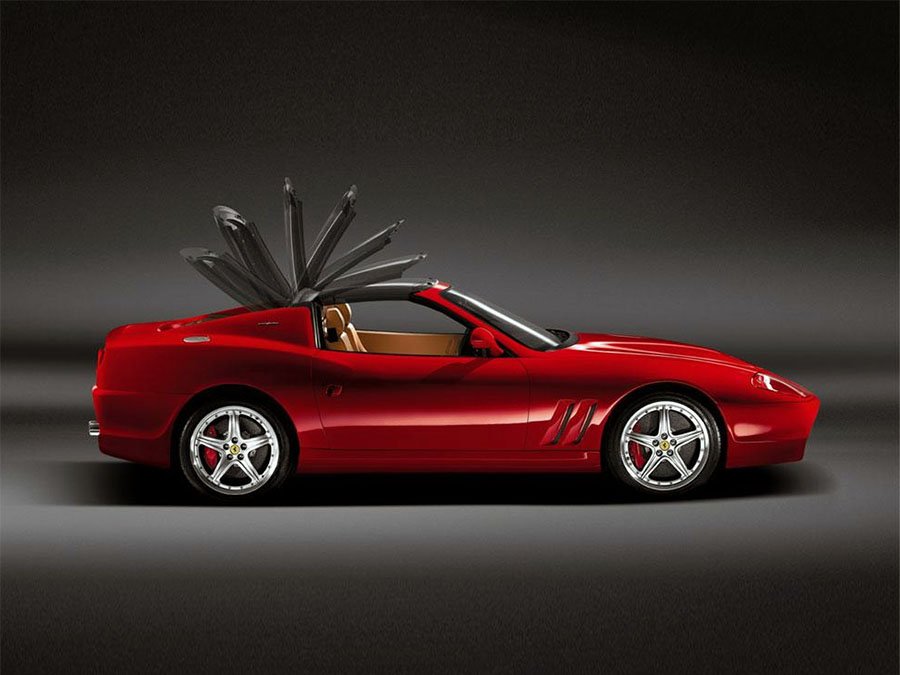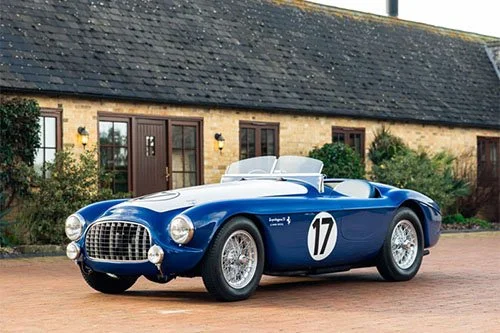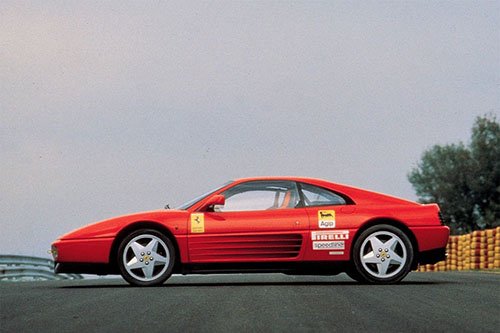Guide: Ferrari 575M Superamerica
Background
When Ferrari launched the 550 Maranello in 1996 it marked a highly anticipated return for a front V12-engined two seater from the house of the prancing horse.
The handsome new model proved both a critical and commercial success; following an absence of more than 20 years, the kind of traditional Grand Tourer that had played a major role in Ferrari’s rise to prominence was back.
Four years after the 550 Maranello broke cover, Ferrari introduced a limited edition Barchetta at the 2000 Paris Motor Show.
Unlike the last front V12-engined Ferrari Spider (the 365 GTS/4 Daytona that proved difficult to shift during the gloomy economic conditions of the early 1970s), this latest iteration of the theme sold out practically overnight. 448 were built and the 550 Barchetta quickly came to be regarded as one of the most highly prized Ferrari road cars of the modern era.
As a consequence, it came as no surprise when Ferrari decided to offer a special open-top version of the 550’s successor: the 575M.
Ferrari had launched the 575M at the Geneva Motor Motor Show in March 2002. Its name referenced an enlarged 5.75-litre engine and further enhanced Modificata specification. Indeed, practically every area of the 550 was improved for this latest iteration; in addition to its bigger, more powerful engine, the 575M’s suspension, brakes and styling came in for considerable attention.
Ferrari also offered the new machine with an optional F1 semi-automatic paddle-shift gearbox which was a first for one of their V12 models.
The open-bodied incarnation of the 575M was unveiled at the Los Angeles Motor Show in January 2005 and proved to be a highly original take on the convertible concept. It also revived a famous name from Ferrari’s past; the Superamerica tag had graced a pair of lavishly engineered flagship models produced in tiny numbers between 1956 and 1964.
The new 575M Superamerica comprised a limited run of 559 units priced at around 25% more than the fixed head variant. Despite the high cost, all had been pre-sold by the time Ferrari presented the first production version in Monaco during May ‘05.
Bodywork
As expected, the most radical changes in the transition to Superamerica trim concerned the 575M’s bodywork.
Pininfarna integrated a Leonardo Fioravanti-patented electric roof that was dubbed Revocromico in recognition of its unusual rearward rotating axis and electrochromic glass technology.
The Superamerica’s carbon-fibre roof was integrated with the rear window to form a single section that was hinged on an axis located at the top of the cockpit sail panels. When activated, the roof rotated on the axis and could be raised or lowered in just seven seconds.
With the roof closed, the Superamerica had all the benefits of a fixed head Berlinetta. When opened, the roof rotated back into a dished recess between the sail panels and the rear screen acted as a wind deflector. Trunk capacity remained unchanged.
Another innovate aspect of the Superamerica’s rotating top was its electrochromic glass technology developed in conjunction with Saint Gobain. The car’s electrochromic glass central roof panel enabled the driver to control the quantity of light that entered the cockpit; five tint levels meant the glass roof could be transformed from dark to light in less than a minute at the touch of a centre console-mounted button.
To accommodate the new roof system, Pininfarina modified the 575M’s back end with sweeping body coloured sail panels, re-profiled rear fenders, a re-profiled tail fascia and a new carbonfibre boot lid. The roofline was also subtly lowered.
Other new features included the aluminium front grille from the HGTC-optioned 575M, an exposed fuel filler cap on the right-hand side rear fender and a body coloured front lip spoiler with matching side sills and rear apron.
Engine / Gearbox
Instead of the Tipo F133 E motor fitted to the standard 575M, Ferrari equipped the Superamerica with an uprated Tipo F133 G engine which was very closely related to the power unit found in the recently introduced 612 Scaglietti.
As per the 612 engine (designated Tipo F133 F) the Tipo F133 G motor ran a higher 11.2:1 compression ratio (up from 11.0:1) along with skimmed heads, revised camshaft timing, 130° intake and exhaust valve seats, slightly enlarged intake lines and the latest Bosch Motronic ME 2.7 engine management.
Peak output was 540bhp at 7250rpm (up from 515bhp at 7250rpm). The torque rating was an unchanged 434lb-ft at 5250rpm.
These engines were identifiable on account of their reversed colour scheme with predominantly red instead of grey intake manifold and head covers.
The rest of the longitudinally-mounted engine’s characteristics were unchanged; they were all-alloy 65° V12s with dual overhead camshafts per bank, four valve cylinder heads, Nikasil-treated liners, forged Mahle pistons, titanium connecting rods and dry-sump lubrication.
Displacement was 5748cc thanks to a bore and stroke of 89mm and 77mm respectively.
Compared to the outgoing 550 engine, the 575M power unit had ushered in new intake fluid dynamics and re-mapped Bosch M5.2 engine management. Variable back-pressure exhausts were retained.
As per the fixed head 575M, Superamerica buyers could choose from one of two rear-mounted gearboxes for their car.
A small number of traditionalists opted for the six-speed manual, but the majority specified Ferrari’s expensive F1 paddle-shift gearbox.
The six-speed F1 unit was built by Graziano Trasmissioni. It offered a fully automatic mode (plus an additional low grip setting) or manual shifting via paddles mounted either side of the steering column behind the steering wheel. When the F1 ‘box was in the manual setting, the driver could select from a Normal or Sport mode via a centre console-mounted switch. In Sport mode, shift times were faster and the dampers automatically firmed up.
Both gearboxes transmitted the power through a single-plate clutch and limited-slip differential.
Chassis
The Superamerica was based on a reinforced version of the standard 575M’s Tipo F133 EBE tubular steel chassis.
Suspension was via independent double wishbones with co-axial coil springs over gas-filled telescopic dampers. Anti-roll bars were fitted at either end. An advanced electronic adaptive control system independently adjusted damper rates to all four wheels and also adjusted the ride height. Two basic ride settings were provided: Sport and Comfort.
Brakes were cross-drilled and ventilated discs of 330mm up front and 310mm at the rear. Light alloy calipers (supplied by Brembo as per the discs) ran a four-piston set-up on each axle.
The latest 5.4 ABS / ASR system was fitted as per the fixed head derivative. The switchable ASR traction control system offered a choice of two settings: Normal and Sport.
Five-spoke split-rim magnesium-alloy Speedline wheels measured 19 x 8.5-inches at the front and 19 x 10.5-inches at the back. Pirelli P Zero Corsa tyres were normally fitted and there was an electronic tyre pressure monitoring system.
The fuel tank (located over the rear axle) had an unchanged capacity of 105-litres.
Interior
The Superamerica’s interior was imported direct from the standard 575M. This in turn was a heavily re-styled version of the outgoing 550 with a completely new dashboard, instrument binnacle and centre console plus new seats, door panels and steering wheel.
All the dials in the 575M were grouped in a single housing directly ahead of the driver. Located in the middle of the binnacle was a 10,000rpm tachometer flanked to the right by a slightly smaller speedometer. Three small read outs (water temperature, oil temperature and oil pressure) were positioned to the left of the rev counter.
A sculpted central control panel was topped by three ventilation blowers under which was an array of switchgear and the audio system. The central control panel along with the dash top, main binnacle and A-pillars were typically upholstered in black leather.
The steering wheel was accessorised with aluminium inserts for the upper spokes.
Six-way electric seats were standard as were electric windows, electric mirrors, air-conditioning and a high end audio system.
Options
Customers could upgrade their 575M Superamerica with a wide array of optional extras. The extensive list of enhancements included racing seats in a choice of three sizes and four-point safety harnesses.. There was also the Fiorano Handling Pack (FHP) that came with stiffer springs, a lower ride height, re-tuned steering software for less assistance at low speeds and uprated brake pads with red calipers.
Other extras included fitted luggage, Daytona seats, contrast seat piping, contrast seat inserts, satellite navigation, Scuderia Ferrari shields for the front fenders, a dedication plaque, a passenger-side airbag deactivation kit, a space-saver wheel, a battery charger, a fire extinguisher, coloured brake calipers (red, yellow or silver), paint and interior surfaces coloured-to-sample and an array of carbonfibre cockpit inserts to included the dash fascia, centre console, doors, steering wheel, gear lever, sill plates, handbrake housing and seat guard covers.
HGTC Handling Pack
Another Superamerica option (and arguably the most sought after) was the he Handling Gran Turismo Competizione pack (HGTC). Unlike the HGTC pack of the standard 575M, the Superamerica bundle came with Bridgestone Potenza instead of Pirelli P Zero Corsa tyres. Otherwise they were identical.
The HGTC pack included everything from the aforementioned Fiorano Handling Pack plus an array of additional enhancements.
Most significantly, the original steel discs were switched to Brembo Carbonfibre-reinforced Silicon Carbide items (CSC). Those at the front went from 330mm to 398mm (with six instead of four-piston calipers) while the rears were enlarged from 310mm to 360mm (where a four-piston set-up was retained).
Coloured brake calipers with the Brembo Carbon Ceramic logo were fitted as standard.
Even stiffer springs were fitted along with a thicker rear anti-roll bar. The HGTC pack also included a re-mapped electronic control unit for the suspension.
Elsewhere, the HGTC bundle included re-mapped gearbox software for faster changes, a lightweight free-flow sports exhaust system and carbonfibre cockpit inserts.
Weight / Performance
At 1790kg, the Superamerica weighed 60kg more than a standard 575M.
A top speed of 199mph (just 4mph less then the fixed head) made it one of the fastest open top cars available.
Both body styles shared an identical 0-62mph time: 4.25 seconds for the manual gearbox and 4.2 if equipped with the F1 unit.
End of Production
Superamerica production ended in early 2006.
559 were built in total.
This figure comprised 496 in left-hand drive (463 with the F1 gearbox and 33 in manual trim) and 63 in right-hand drive (57 with the F1 gearbox and six in manual trim).
Text copyright: Supercar Nostalgia
Photo copyright: Ferrari - https://www.ferrari.com







































